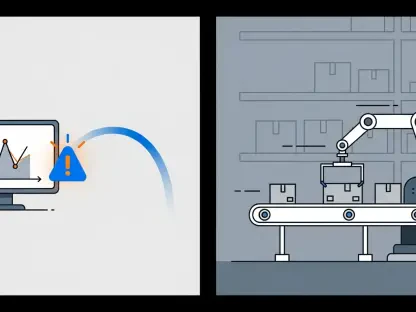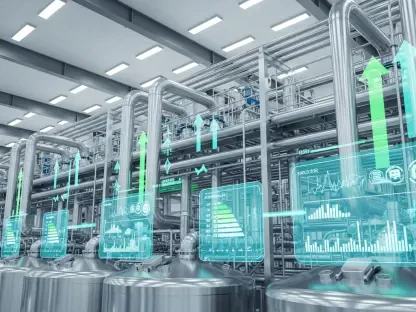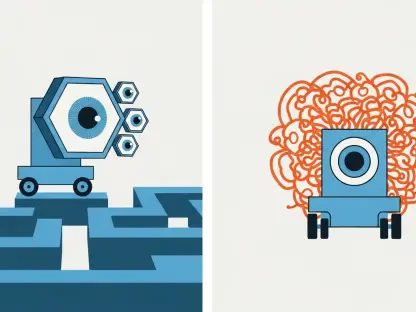In the high-stakes world of industrial engineering, a single undetected structural flaw can lead to catastrophic failures, costing billions in damages and endangering countless lives. Industries such as aerospace, energy, and civil infrastructure depend on the precision of non-destructive testing (NDT) to ensure safety and reliability, yet traditional methods often fail to detect hidden internal defects. Enter AI diffusion models—a groundbreaking technology that promises to transform how defects are visualized and managed. This review delves into the capabilities of these advanced generative systems, exploring their role in overcoming longstanding challenges in NDT and their potential to redefine safety standards across critical sectors.
Understanding the Core of AI Diffusion Models
AI diffusion models represent a cutting-edge class of generative artificial intelligence designed to simulate high-fidelity data with remarkable accuracy. Unlike conventional AI approaches, these models iteratively refine noise into structured outputs, creating realistic simulations of complex phenomena. In the context of NDT, they excel at reconstructing detailed images of internal structural flaws that physical sensors, such as ultrasonic or electromagnetic devices, often miss due to material distortions or geometric complexities.
The significance of this technology lies in its ability to address critical gaps in industrial diagnostics. Where traditional methods struggle with data scarcity and imprecise readings, diffusion models generate synthetic yet reliable datasets to train diagnostic systems. This capability not only enhances the precision of defect detection but also ensures that industries can maintain safety without invasive testing, marking a pivotal shift in engineering practices.
Key Features and Performance in NDT
Generative Precision for Enhanced Diagnostics
One of the standout features of AI diffusion models is their generative capacity to produce detailed simulations of structural defects. By mimicking real-world ultrasonic imaging, these models create virtual representations of cracks or flaws hidden deep within materials. This ability proves invaluable in industries where even microscopic imperfections can have dire consequences, allowing for early identification and intervention.
Beyond visualization, the technology tackles the persistent issue of limited training data in NDT. Generating synthetic defect scenarios enables continuous improvement of diagnostic algorithms, ensuring they adapt to diverse materials and conditions. The result is a level of diagnostic accuracy that surpasses traditional sensors, setting a new benchmark for reliability in safety-critical applications.
Real-Time Integration with Systems Like DiffectNet
A prime example of AI diffusion models in action is DiffectNet, a diffusion-enabled network tailored for NDT. This system integrates seamlessly with existing ultrasonic testing frameworks, reconstructing internal flaws in real time with unprecedented clarity. Unlike conventional sensors that often require extensive manual interpretation, DiffectNet automates the process, reducing human error and accelerating decision-making.
Performance-wise, DiffectNet outshines traditional methods by minimizing distortions caused by complex geometries or material properties. Its non-invasive approach ensures that structures remain intact during testing, preserving operational continuity. Such advancements highlight how AI can enhance not just accuracy but also efficiency in high-pressure industrial environments.
Innovations Driving Industry Transformation
Recent developments in AI diffusion models have pushed the boundaries of virtual defect engineering, enabling simulations that mirror real-world conditions with striking fidelity. Innovations in real-time data analysis allow for immediate defect detection, a crucial advantage in sectors where downtime equates to significant losses. These breakthroughs signal a move toward proactive rather than reactive defect management.
A notable trend is the deeper integration of AI into industrial safety systems. From automated monitoring in power plants to quality assurance in semiconductor production, the technology is becoming a cornerstone of operational protocols. This shift is redefining industry standards, prioritizing precision and prevention over outdated, less reliable methods.
The momentum behind these innovations suggests a broader acceptance of AI-driven solutions in engineering. As computational power and algorithmic efficiency continue to improve from this year into 2027, the adoption of diffusion models is expected to accelerate, embedding intelligent diagnostics into the fabric of industrial workflows.
Applications Across Critical Sectors
The practical impact of AI diffusion models spans a wide array of industries, each benefiting from enhanced safety and operational efficiency. In aerospace, real-time monitoring of aircraft components ensures that hidden cracks are detected before they compromise flight safety. Similarly, in the energy sector, the technology safeguards power plant infrastructure by identifying internal wear that could lead to catastrophic breakdowns.
In advanced manufacturing, such as semiconductor production, these models facilitate quality control by virtually reconstructing defects without halting production lines. Meanwhile, civil infrastructure projects leverage AI for structural health assessments, monitoring bridges and buildings to prevent failures before they become visible threats. This versatility underscores the technology’s transformative potential across diverse applications.
Unique use cases further illustrate the adaptability of diffusion models. For instance, in automotive manufacturing, they enable precise evaluation of critical components under stress, ensuring vehicle safety. Such varied implementations demonstrate that AI is not a one-size-fits-all solution but a flexible tool capable of addressing specific industry challenges.
Challenges Hindering Wider Adoption
Despite their promise, AI diffusion models face significant technical hurdles that limit their scalability. The need for vast amounts of training data, even when synthetically generated, poses a challenge for smaller organizations with limited resources. Additionally, the computational intensity of these models demands robust infrastructure, often out of reach for some industrial players.
Regulatory and ethical concerns also loom large, particularly in safety-critical sectors. Questions about the reliability of AI-driven diagnostics and the potential for over-reliance on automated systems require careful consideration. Establishing standardized protocols for validation and accountability remains a pressing need to ensure trust in these technologies.
Ongoing research aims to address these limitations by enhancing model efficiency and reducing dependency on extensive datasets. Efforts to integrate diffusion models with existing NDT frameworks are underway, seeking to balance innovation with practicality. Until these challenges are resolved, widespread adoption may remain constrained in certain contexts.
Looking Ahead to Future Possibilities
The trajectory of AI diffusion models points toward significant advancements in learning capabilities and industrial integration over the coming years. Potential improvements in algorithmic efficiency could lower computational barriers, making the technology accessible to a broader range of users. Such progress would democratize access to cutting-edge diagnostics, leveling the playing field across industries.
The long-term impact on engineering practices is poised to be profound, with AI expected to redefine safety standards and urban infrastructure resilience. Intelligent systems could evolve into active participants in design and maintenance, anticipating issues before they arise. This vision of AI as a collaborative partner in engineering opens new avenues for innovation and reliability.
Speculation on future developments suggests that diffusion models might expand beyond NDT into other complex problem-solving domains. Their ability to simulate intricate scenarios could influence fields like material science or predictive maintenance, further cementing AI’s role in shaping industrial landscapes. The horizon appears rich with possibilities for those willing to invest in this technology.
Final Thoughts and Next Steps
Reflecting on this exploration, it is evident that AI diffusion models have carved a transformative path in non-destructive testing, offering unparalleled precision in visualizing hidden defects. Their performance in real-time diagnostics and integration with systems like DiffectNet has already demonstrated a marked improvement over traditional methods. The breadth of applications across industries underscores their versatility and potential to elevate safety standards.
Moving forward, stakeholders need to prioritize research into reducing computational demands and addressing data challenges to broaden accessibility. Collaborative efforts between industry leaders and regulators are essential to establish guidelines that ensure ethical and reliable use of AI diagnostics. Investing in pilot programs could also accelerate adoption, providing real-world data to refine these models further.
Ultimately, the journey of AI diffusion models has just begun, and the next steps involve fostering partnerships to tackle scalability and trust issues. By focusing on incremental improvements and cross-sector collaboration, the industrial world can harness this technology to build safer, more resilient systems for the future.









